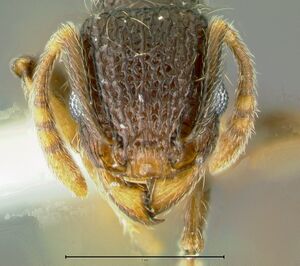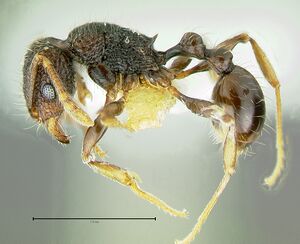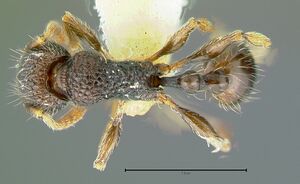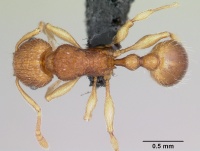Tetramorium tonganum
| Tetramorium tonganum | |
|---|---|

| |
| Scientific classification | |
| Kingdom: | Animalia |
| Phylum: | Arthropoda |
| Class: | Insecta |
| Order: | Hymenoptera |
| Family: | Formicidae |
| Subfamily: | Myrmicinae |
| Tribe: | Crematogastrini |
| Genus: | Tetramorium |
| Species group: | tonganum |
| Species: | T. tonganum |
| Binomial name | |
| Tetramorium tonganum Mayr, 1870 | |
| Synonyms | |
| |
A widely ranging species that occurs in a variety of forest habitats. Heterick & Kitching (2022) collected this species (or one close to it) in the canopy of a lowland dipterocarp forest in Brunei.
| At a Glance | • Invasive |
Identification
Bolton (1977) - The distribution of this species in Polynesia has been covered in some detail by Wilson and Taylor (1967) but the range of the species extends from Japan in the north to New Guinea in the south. The east-west distribution is more difficult to ascertain as the species is capable of being transported by human commerce, but it is probably safe to say that Java and Sumba represent the western limits of tonganum. A Malayan record noted below was made in the Botanical Gardens of Kuala Lumpur and I suspect that it may represent an introduction. Similarly with the collection from Sri Lanka which makes up the type-series of the synonymous Tetramorium magitae.
Keys including this Species
Distribution
Bolton (1977) - The closest relative of tonganum is certainly the species Tetramorium difficile from Nepal and Bhutan, but this is smaller, with relatively shorter antennal scapes. The legs of difficile are shorter and the pronotal corners are more sharply angulate in dorsal view. Also in difficile the propodeum is usually armed with only a pair of minute, acute denticles. A second closely related species, Tetramorium vandalum, occurs in New Guinea, but this is blackish brown in colour and has erect and suberect pubescence upon the dorsal (outer) hind tibial surface. To some extent vandalum may exclude tonganum from New Guinea, as collections of the latter species are rare from that island.
Latitudinal Distribution Pattern
Latitudinal Range: 14.297° to -22.6517°.
| North Temperate |
North Subtropical |
Tropical | South Subtropical |
South Temperate |
- Source: AntMaps
Distribution based on Regional Taxon Lists
Australasian Region: New Caledonia.
Indo-Australian Region: Borneo, Brunei Darussalam, Cook Islands, Fiji, French Polynesia, Guam, Indonesia, Malaysia, Marshall Islands, Micronesia (Federated States of), New Guinea, Niue, Palau, Philippines, Samoa, Singapore, Solomon Islands, Tokelau, Tonga (type locality), Vanuatu, Wallis and Futuna Islands.
Oriental Region: Sri Lanka.
Palaearctic Region: China, Japan.
Distribution based on AntMaps
Distribution based on AntWeb specimens
Check data from AntWeb
Countries Occupied
| Number of countries occupied by this species based on AntWiki Regional Taxon Lists. In general, fewer countries occupied indicates a narrower range, while more countries indicates a more widespread species. |

|
Estimated Abundance
| Relative abundance based on number of AntMaps records per species (this species within the purple bar). Fewer records (to the left) indicates a less abundant/encountered species while more records (to the right) indicates more abundant/encountered species. |

|
Biology
Castes
Worker
  
| |
| . | |
Nomenclature
The following information is derived from Barry Bolton's Online Catalogue of the Ants of the World.
- tonganum. Tetramorium tonganum Mayr, 1870b: 976 (w.) TONGA. Santschi, 1928a: 50 (q.); Bharti & Kumar, 2012b: 23 (m.). Senior synonym of magitae: Bolton, 1977: 129.
- magitae. Tetramorium magitae Forel, 1911i: 224 (w.) SRI LANKA. [Misspelled as mayitae in original.] Junior synonym of tonganum: Bolton, 1977: 129.
Unless otherwise noted the text for the remainder of this section is reported from the publication that includes the original description.
Note that all records reported as this species from India by Bharti & Kumar (2012) and Bharti et al. (2016) are based on a misidentification in Bharti & Kumar (2012) and are actually Tetramorium salvatum (Agavekar et al., 2017).
Description
Worker
TL 2.6-3.1, HL 0.62-0.72, HW 0.56-0.64, CI 85-91, SL 0.46-0.54, SI 80-87, PW 0.40-0.48, AL 0.70-0.84 (36 measured).
Mandibles striate; anterior clypeal margin entire and the median portion of the clypeus with a narrow but fairly conspicuous anterior flange or apron. Frontal carinae extending back well beyond the level of the eyes, usually approaching the occipital margin, the carinae themselves not strongly developed but always more conspicuous than any other cephalic sculpture. Scapes relatively long (see SI above), if laid back in the rather shallow scrobes the apex of the scape just fails to reach the occipital corner. Eyes moderate in size, maximum diameter c. 0.14-0.16, about 0.24-0.27 x HW. Pronotum in dorsal view with the anterolateral angles broadly rounded. Propodeal spines relatively short, at most only marginally longer than the broadly triangular metapleural lobes, the spines narrow and acute. In some samples the propodeal armament is reduced to a pair of acute triangular teeth. Petiole in profile with an elongate, narrow peduncle anteriorly which in most is downcurved along its length. In some individuals the curvature appears reduced but the ventral surface of the peduncle always passes through a rounded angle before its junction with the node. Shape of petiole and postpetiole in profile are as shown in figure; in dorsal view the petiole node subglobular. Dorsum of head predominantly longitudinally ruguiose, with few or no cross-meshes before the level of the posterior margins of the eyes; behind this cross-meshes become more conspicuous, and a reticulum is usually present occipitally. Dorsal alitrunk finely reticulate-rugulose. Petiole and postpetiole predominantly smooth, completely unsculptured in some but often with at least traces of sculpture on the petiole, less commonly with traces on postpetiole also. Gaster unsculptured. All dorsal surfaces with numerous fine hairs of varying length but scapes and hind tibiae only with decumbent short pubescence, without erect pilosity of any description. Colour varying from light yellowish brown to mid-brown, often with the gaster somewhat darker than the head and alitrunk.
Type Material
Syntype workers, Tonga: Tongtabu (Godeffroy) (Naturhistorisches Museum Wien, Vienna) [examined].
References
- Agavekar, G., Hita Garcia, F., Economo, E.P. 2017. Taxonomic overview of the hyperdiverse ant genus Tetramorium Mayr (Hymenoptera, Formicidae) in India with descriptions and X-ray microtomography of two new species from the Andaman Islands. PeerJ 5:e3800 (DOI 10.7717/peerj.3800).
- Bharti, H. & Kumar, R. 2012. Taxonomic studies on genus Tetramorium Mayr (Hymenoptera, Formicidae) with report of two new species and three new records including a tramp species from India with a revised key. ZooKeys. 207:11-35. doi:[http://dx.doi.org/10.3897/zookeys.207.3040 10.3897/zookeys.207.3040
- Bolton, B. 1977. The ant tribe Tetramoriini (Hymenoptera: Formicidae). The genus Tetramorium Mayr in the Oriental and Indo-Australian regions, and in Australia. Bulletin of the British Museum (Natural History). Entomology. 36:67-151. (page 129, Senior synonym of magitae)
- Brassard, F., Leong, C.-M., Chan, H.-H., Guénard, B. 2021. High diversity in urban areas: How comprehensive sampling reveals high ant species richness within one of the most urbanized regions of the world. Diversity 13, 358 (doi:10.3390/d13080358).
- Heterick, B.E., Kitching, R.L. 2022. The ants (Hymenoptera: Formicidae) of a one-hectare plot of lowland dipterocarp forest. Entomologist’s Monthly Magazine 158(4), 261–272 (doi:10.31184/m00138908.1584.4153).
- Imai, H.T., Kihara, A., Kondoh, M., Kubota, M., Kuribayashi, S., Ogata, K., Onoyama, K., Taylor, R.W., Terayama, M., Yoshimura, M., Ugawa, Y. 2003. Ants of Japan. 224 pp, Gakken, Japan.
- Liu, C., Fischer, G., Hita Garcia, F., Yamane, S., Liu, Q., Peng, Y.Q., Economo, E.P., Guénard, B., Pierce, N.E. 2020. Ants of the Hengduan Mountains: a new altitudinal survey and updated checklist for Yunnan Province highlight an understudied insect biodiversity hotspot. ZooKeys 978, 1–171 (doi:10.3897/zookeys.978.55767).
- Mayr, G. 1870b. Neue Formiciden. Verh. K-K. Zool.-Bot. Ges. Wien 20: 939-996 (page 976, worker described)
- Santschi, F. 1928a. Formicidae (Fourmis). Insects Samoa 5: 41-58 (page 50, queen described)
- Subedi, I.P., Budha, P.B. 2019. Status of ant research and species first described from Nepal with new distribution records. Journal of Natural History Museum. 31:57-78.
- Wang, W.Y., Soh, E.J.Y., Yong, G.W.J., Wong, M.K.L., Benoit Guénard, Economo, E.P., Yamane, S. 2022. Remarkable diversity in a little red dot: a comprehensive checklist of known ant species in Singapore (Hymenoptera: Formicidae) with notes on ecology and taxonomy. Asian Myrmecology 15: e015006 (doi:10.20362/am.015006).
- Yamane, S., Hosoishi, S., Ito, F. 2022. Japanese Tetramorium queens: identification key and species diagnoses (Hymenoptera, Formicidae, Myrmicinae). ZooKeys 1084: 43–64 (doi:10.3897/zookeys.1084.69767).
References based on Global Ant Biodiversity Informatics
- Abbott K.L., S.N.J. Greaves, P.A. Ritchie, P.J. Lester. Behaviourally and genetically distinct populations of an invasive ant provide insights into invasion history and impacts on a tropical ant community. Biological Invasions 9: 453-463.
- Abbott KL, Greaves SNJ, Ritchie PA, Lester PJ. 2007. Behaviorally and genetically distinct populations of an invasive ant provide insight into invasion history and impacts on a tropical ant community. Biological Invasions 9:453-463
- Abbott, K.L., M. Sarty and P.J. Lester. 2006. The ants of Tokelau. New Zealand Journal of Zoology. 33:157-164.
- Abbott, K.L., M. Sarty, P.J. Lester. 2006. The ants of Tokelau. New Zealand Journal of Zoology 33:157-164.
- Bolton B. 1977. The ant tribe Tetramoriini (Hymenoptera: Formicidae). The genus Tetramorium Mayr in the Oriental and Indo-Australian regions, and in Australia. Bulletin of the British Museum (Natural History). Entomology 36:67-151.
- Bolton, B. "The ant tribe Tetramoriini (Hymenoptera: Formicinae. The genus Tetramorium Mayr in the Oriental and Indo-Australian regions and in Australia." Bulletin of the British Museum (National History): Entomology series 36, no. 2 (1977): 68-151.
- Chapman, J. W., and Capco, S. R. 1951. Check list of the ants (Hymenoptera: Formicidae) of Asia. Monogr. Inst. Sci. Technol. Manila 1: 1-327
- Chazeau J., H. Jourdan, L. Bonnet de Larbogne, J. Konghouleux, and T. Potiaroa. 2003. Etude floristique et faunistique de la foret seche de Nekoro, 2 eme partie: evaluation de l'integrite de la faune par l'etude de la myrmecofaune. Lettre de Commande Programme Forêt Sèche /lRD N°l 54/2002/CP
- Cheesman L. E., and W. C. Crawley. 1928. A contribution towards the insect fauna of French Oceania. - Part III. Formicidae. Ann. Mag. Nat. Hist. 10(2): 514-525.
- Chessman, L. E. and Crawley, W. C. 1928. A Contribution towards the Insect Fauna of French Oceania. Annals and Magazine of Natural History. 2(10):514-525.
- Clouse R. M. 2007. The ants of Micronesia (Hymenoptera: Formicidae). Micronesica. 39: 171-295.
- Clouse, R.M. 2007. The ants of Micronesia (Hymenoptera: Formicidae), Micronesica 39(2): 171-295.
- Collingwood, C. A. and Van Harten, Antonius. 2001. The Ants (Hym., Formicidae)of Niue, Souh West Pacific. Entomologist's Monthly Magazine. 137:139-143.
- Dahl F. 1901. Das Leben der Ameisen im Bismarck-Archipel, nach eigenen Beobachtungen vergleichend dargestellt. Mitt. Zool. Mus. Berl. 2: 1-70.
- Dlussky G.M. 1994. Zoogeography of southwestern Oceania. Zhivotnoe naselenie ostrovov Iugo-Zapadnoi Okeanii ekologo-geograficheskie issledovanii 48-93.
- Emery C. Formiche raccolte da Elio Modigliani in Sumatra, Engano e Mentawei. Annali del Museo Civico di Storia Naturale 40: 661-722.
- Emery, C. "Formiche raccolte da Elio Modigliani in Sumatra, Engano e Mentawei." Annali del Museo Civico di Storia Naturale Giacomo Doria (Genova) (2) 20, no. 40 (1900): 661-722.
- Evenhuis N. L., L. G. Eldredge, K. T. Arakaki, D. Oishi, J. N. Garcia, and W. P. Haines. 2010. Terrestrial arthropods surveys on Pagan Island, Northern Marianas. U.S. Fish and Wildlife Service, Pacific Islands Fish & Wildlife Office Honolulu, Hawaii. 72 pages.
- Field Museum Collection, Chicago, Illinois (C. Moreau)
- Forel A. 1901. Formiciden aus dem Bismarck-Archipel, auf Grundlage des von Prof. Dr. F. Dahl gesammelten Materials. Mitt. Zool. Mus. Berl. 2: 4-37.
- General D. M., and G. D. Alpert. 2012. A synoptic review of the ant genera (Hymenoptera, Formicidae) of the Philippines. Zookeys 200: 1-111.
- Janda M., G. D. Alpert, M. L. Borowiec, E. P. Economo, P. Klimes, E. Sarnat, and S. O. Shattuck. 2011. Cheklist of ants described and recorded from New Guinea and associated islands. Available on http://www.newguineants.org/. Accessed on 24th Feb. 2011.
- Jennings J. T., L. Krogmann, and C. Burwell. 2013. Review of the hymenopteran fauna of New Caledonia with a checklist of species. Zootaxa 3736(1): 1-53.
- Kami K.S., and S. E. Miller. 1998. Samoan insects and related arthropods: checklist and bibliography. Bishop Museum Technical Report 13, pp 121.
- Kami KS & Miller SE. 1998. Samoan insects and related arthropods: checklist and bibliography. Bishop Museum Technical Report No. 13.
- Lester, Philip J. et al. 2009. Competitive assembly of South Pacific invasive ant communities. BMC Ecology. 1-27.
- Li Z.h. 2006. List of Chinese Insects. Volume 4. Sun Yat-sen University Press
- Mann W. M. 1919. The ants of the British Solomon Islands. Bulletin of the Museum of Comparative Zoology 63:273-391.
- Mann W. M. 1921. The ants of the Fiji Islands. Bulletin of the Museum of Comparative Zoology 64: 401-499.
- Mann William. 1916. The Ants of the British Solomon Islands. Bulletin of the Museum of Comparative Zoology at Harvard College 63(7): 273-391
- Mann, W.M. 1919. The ants of the British Solomon Islands. Bulletin of the Museum of Comparative Zoology of Harvard College 63: 273-391
- Morrison L. W. 1996. The ants (Hymenoptera: Formicidae) of Polynesia revisited: species numbers and the importance of sampling intensity. Ecography 19: 73-84.
- Morrison L. W; 2008. Patterns of nestedness in remote Polynesian ant faunas (Hymenoptera: Formicidae). Pacific Science 62(1): 117-127.
- Morrison L.W. 1997. Polynesian ant (Hymenoptera: Formicidae) species richness and distribution: a regional survey. Acta Oecologica 18(6): 685-695.
- Morrison LW. 2008. Patterns of Nestedness in remote Polynesian ant faunas. Pacific Science 117-127.
- Morrison LW. 2008. Patterns of nestedness in remote Polynesian ant faunas. Pacific Science 62(1):117-127.
- Perrault G.H. 1988. Les fourmis de Tahiti. Bull. Soc. Zool. France 112(3-4): 430-446.
- Pfeiffer M., and D. Mezger. 2012. Biodiversity Assessment in Incomplete Inventories: Leaf Litter Ant Communities in Several Types of Bornean Rain Forest. PLoS ONE 7(7): e40729. doi:10.1371/journal.pone.0040764
- Pfeiffer M., and D. Mezger. 2012. Biodiversity Assessment in Incomplete Inventories: Leaf Litter Ant Communities in Several Types of Bornean Rain Forest. PLoS ONE 7(7): e40729. doi:10.1371/journal.pone.0040896
- Pfeiffer M.; Mezger, D.; Hosoishi, S.; Bakhtiar, E. Y.; Kohout, R. J. 2011. The Formicidae of Borneo (Insecta: Hymenoptera): a preliminary species list. Asian Myrmecology 4:9-58
- Pfeiffer, M., H. Cheng Tuck, and T. Chong Lay. 2008. Exploring arboreal ant community composition and co-ccurrence patterns in plantations of oil palm Elaeis guineensis in Borneo and Peninsular Malaysia. Ecography 31(1): 21-32.
- Ramage T. 2014. Les fourmis de Polynesie francaise (Hymenoptera, Formicidae). Bulletin de la Société entomologique de France 119 (2): 145-176.
- Room P. M. 1975. Diversity and organization of the ground foraging ant faunas of forest, grassland and tree crops in Papua Nez Guinea. Aust. J. Zool. 23: 71-89.
- Room, P.M. 1975. Relative Distributions of Ant Species in Cocoa Plantations in Papua New Guinea Relative Distributions of Ant Species in Cocoa Plantations in Papua New Guinea. Journal of Applied Ecology 12(1):47-61
- Santschi F. 1928. Formicidae (Fourmis). Insects Samoa. 5: 41-58.
- Sarnat Eli M. 2009. The Ants [Hymenoptera: Formicdiae] of Fiji: Systematics, Biogeography and Conservation of an Island Arc Fauna. 80-252
- Savage, A.M., J.A. Rudgers and K.D. Whitney. 2009. Elevated Dominance of Extrafloral Nectary-Bearing Plants Is Associated with Increased Abundances of an Invasive Ant and Reduced Native Ant Richness. Diversity and Distributions 15(5): 751-761
- Taylor R. W. 1976. The ants of Rennell and Bellona Islands. Natural History of Rennell Island, British Solomon Islands 7: 73-90.
- Taylor, R. W. 1967. Entomological Survey of the Cook Islands and Niue. New Zealand Journal of Science. 10(4):1092-95.
- Terayama M., S. Kubota, and K. Eguchi. 2014. Encyclopedia of Japanese ants. Asakura Shoten: Tokyo, 278 pp.
- Terayama, M.; Miyano, S.; Kurozumi, T. 1994. Ant fauna (Insecta: Hymenoptera: Formicidae) of the northern Mariana Islands, Micronesia. Natural History Research Special Issue 1:231-236.
- Terayama. M. 2004. Geological and ecological distribution of Japanese ants communities. (translated from Japanese) Reports of the Saitama Prefecture Animal Research Association. 48:27
- Viehmeyer H. 1912. Ameisen aus Deutsch Neuguinea gesammelt von Dr. O. Schlaginhaufen. Nebst einem Verzeichnisse der papuanischen Arten. Abhandlungen und Berichte des Königlichen Zoologischen und Anthropologische-Ethnographischen Museums zu Dresden 14: 1-26.
- Ward, Darren F. and James K. Wetterer. 2006. Checklist of the Ants of Fiji. Fiji Arthropods III 85: 23-47.
- Ward, Darren and Beggs, Jacqueline. 2007. Coexistence, habitat patterns and the assembly of ant communities in the Yasawa islands, Fiji. Ant Oecologica. 32:215-223.
- Wetterer, James K. 2002. Ants of Tonga. Pacific Science. 56.2: 125-135.
- Wetterer, James K. 2006. Ants (Hymenoptera: Formicidae) of Niue, Polynesia. Pacif Science. 60:(3)413-416.
- Wetterer, James K. and Vargo, Donald Vargo L. 2003. Ants (Hymenoptera: Formicidae) of Samoa. Pacific Science. 57(4):409-419.
- Wheeler W. M. 1937. Additions to the ant-fauna of Krakatau and Verlaten Island. Treubia 16: 21-24.
- Wheeler W.M. 1935. Check list of the ants of Oceania. Occasional Papers of the Bernice Pauahi Bishop Museum 11(11):1-56.
- Wheeler, W. M. 1936. Ants from the Society, Austral, Tuamotu and Mangareva Islands. Occasional Papers of the Bernice Pauahi Bishop Museum 12(18):3-17.
- Wheeler, William Morton. 1932. Ants from the Society Islands. Bernice P. Bishop Museum Bulletin. 113:13-19.
- Wheeler, William Morton. 1932. Ants of the Marquesas Islands. Bernice P. Bishop Museum-Bulletin. 98:155-63
- Wheeler, William Morton. 1936. Ants from the Society, Austral, Tuamotu, and Mangareva Islands. Bernice P. Bishop Museum Occasional Papers 7.18.
- Wheeler, William Morton.1935.Checklist of the Ants of Oceania.Occasional Papers 11(11): 3-56
- Wilson E. O.; Taylor, R. W. 1967. The ants of Polynesia (Hymenoptera: Formicidae). Pacific Insects Monograph 14:1-109.
- Wilson E.O., and G.L. Hunt. 1967. Ant fauna of Futuna and Wallis islands, stepping stones to Polynesia. Pacific Insects 9(4): 563-584.
- Wilson EO & Hunt GL. 1967. Ant fauna of Futuna and Wallis Islands, stepping stones to Polynesia. Pacific Insects 9.4: 563-584.
- Wilson EO, Hunt GL. 1967. Ant fauna of Futuna and Wallis Islands, stepping stones to Polynesia. Pacific Insects 9.4: 563-584.
- Wilson EO, Taylor RW. 1967. The ants of Polynesia. Pacific Insects Monograph 14:1-109.
- Wilson, Edward O. 1959. The Ants of Rennell and Bellona Islands. Nat. Hist. Rennell Isl. By Solomon Isl. 4:13-23.
- Wilson, Edward O. and George L. Hunt. 1967. Ant Fauna of Futuna and Wallis Islands, Stepping Stones To Polynesia. Pacific Insects. 9(4):563-584.
- Wilson, Edward O. and Hunt, George L. Jr. 1967. Ant Fauna of Futuna and Wallis Islands, Stepping Stones to Polynesia. Pacific Insects. 9(4):563-584
- Yamane S. 2013. A Review of the ant fauna of the Krakatau Islands, Indonesia. Bull. Kitakyushu Mus. Nat. Hist. Hum. Hist. Ser: A, 11: 1-66
- Yamane Sk. 2005. Krakatau in 1982, and the commencement of myrmecological research. The nature and Insects (Konchu to shizen) 40: 27-33.


